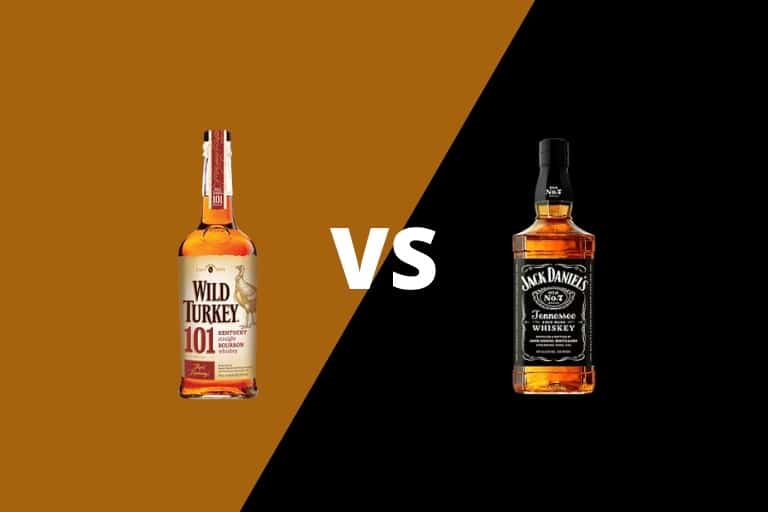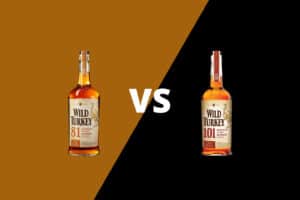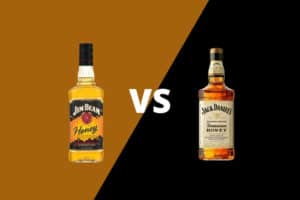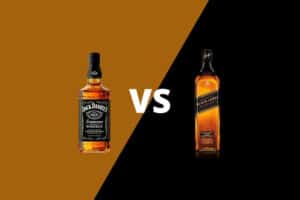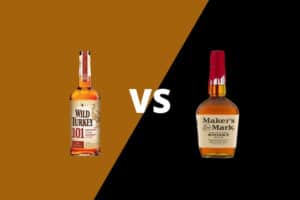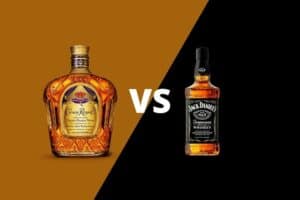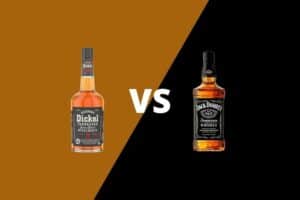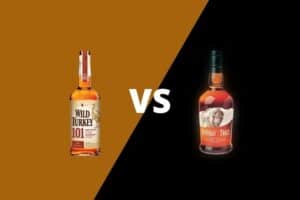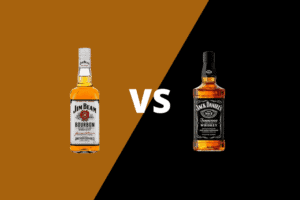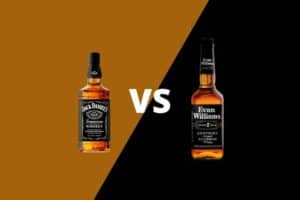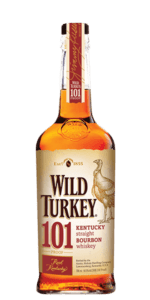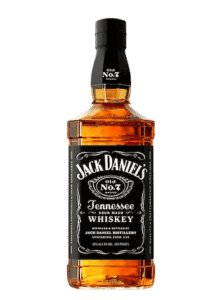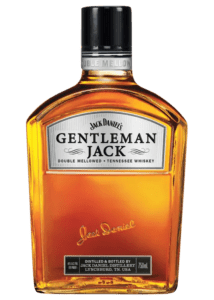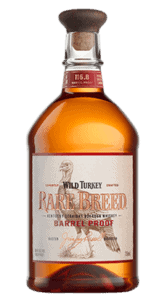Wild Turkey and Jack Daniel’s are two distinctly American brands familiar with newcomers to the American whiskey category and ardent whiskey drinkers alike. While both are popular choices at pubs and taverns across the United States, most seasoned bourbon drinkers have their favorite.
In this point, we’ll help you understand the pros and cons of each — and how a charcoal mellowing process and other production methods used by the respective teams of whiskey makers affect the finished product. We’ll explain why your taste buds perceive each spirit differently when poured straight in a glass or used as the main ingredient in bourbon cocktails so that you can make an informed decision the next time you’re ordering at the bar or picking up a bottle from your favorite whiskey shop.
Table of Contents
History
In 1849, a boy named Jasper ‘Jack’ Newton Daniel was born in Lynchburg, Tennessee. From a young age he took an interest in a neighbor’s cabin still, where a slave named Nearest Green taught him how to distill excess grain from surrounding farms into whiskey.
Jack’s mother died when he was a small child and when his father died during the Civil War, he fled the family home. After the war ended, there was a booming demand for whiskey in reconstruction Tennessee. So, Daniel opened a distillery in 1875 and took on Nearest to help lead operations at the site.
Austin Nichols was a wholesaler based in New York City who distributed whiskey made by their primary supplier, the Ripy family in Tyrone, Kentucky. Nichols began selling products in 1855.
Both businessmen did well during the reconstruction period and expanded operations during the 19th century. However, nationwide Prohibition halted commercial alcohol sales in the United States from 1920 to 1933.
After repeal, both brands jumped into the surge in demand to help quench the thirst of a nation. Legend has it that during this time, Earnest W. Ripy rebuilt the distillery with his bare hands from scratch in 1935 to get operations off the ground. The facility eventually became known as the J.T.S. Brown Distillery.
Soon after, in 1940, an executive at the distillery named Thomas McCarthy took barrel samples on a hunting trip for wild turkey with friends and business associates — including members of the Austin Nichols company. The barrel-proof whiskey was considered a hit, and the Wild Turkey 101 brand was launched two years later.
In 1954, the distillery hired Jimmy Russell, the Bourbon Hall of Fame master distiller who is still involved with the brand.
During this period, the Jack Daniel’s brand continued as a regional brand with moderate success. In 1956, Brown-Forman acquired Jack Daniel’s brand and its facilities. With the backing of a large international company, Jack Daniel’s enjoyed a push into new markets, where it found success on the back bar of live venues during the emerging rock and roll scene.
The Austin Nichols company purchased the J.T.S. Brown Distillery in 1971 and changed the name to the Wild Turkey Distillery. In 1980, Wild Turkey was acquired by French drinks giant Pernod-Richard.
Mashbills
Although Wild Turkey 101 is a bourbon and Jack Daniel’s is considered a Tennessee whiskey, the grain requirements are the same. Like bourbon, Tennessee whiskey is required by regulation to be made from a grain bill that includes at least 50 percent corn.
The mash bill or list of grain ingredients for Jack Daniel’s is 80 percent corn, 8 percent rye and 12 percent malted barley. The grain bill for Wild Turkey is 75 percent corn, 13 percent rye and 12 percent malted barley.
Wild Turkey Master Distiller Jimmy Russell, along with many whiskey fanatics, considers Wild Turkey a high-rye bourbon — one that includes a higher percentage of spicy rye grain in the mash bill, which offers a bold and robust flavor profile in the finished product. Contrast this style to the additional corn in the mash bill for Jack Daniel’s, which gives the resulting whiskey additional sweet corn notes.
Distillation & Production
Both Jack Daniel’s and Wild Turkey are produced in modern facilities that utilize continuous column distillation to make their whiskeys.
The Jack Daniel’s Distillery in Lynchburg, Tennessee, is the largest distillation plant in North America. The Wild Turkey distillery in Lawrenceburg, Kentucky, is medium-sized.
By way of comparison, the Jack Daniel’s Distillery operates six columns — two 72-inch and four 53-inch stills — while the Wild Turkey Distillery still is 60-inches in diameter.
Both distilleries have access to a prime limestone-filtered water source. The Wild Turkey Distillery pulls water from below the limestone shelf of the nearby Kentucky River, while Jack Daniel’s utilizes the spring-fed limestone cave under the Elk River. In 1941, Master Distiller Lem Tolley erected a life-sized statue of Jack Daniel in front of the cave spring, where visitors can cool down in the constant 55-degree spring water during the peak of Kentucky’s hot and muggy summers.
Both brands have family lineages in their respective production departments that go back decades. Wild Turkey Master Distiller Jimmy Russell has been with the company since 1954 and still plays a role with the company. Among the many innovations from Jimmy Russell was the introduction of Wild Turkey Liqueur with Honey in 1975, considered the first flavored bourbon — a thriving category today that has introduced thousands of new whiskey fans to the bourbon category. Wild Turkey Liqueur has been rebranded as American Honey, which continues to be a driver of segment growth. Jimmy’s son Eddie Russel is the active Master Distiller for Wild Turkey.
Over at Brown-Forman, the current Master Distiller at Jack Daniel’s Lynchburg distillery is Chris Fletcher, the grandson of Master Distiller Frank Bobo, who was at the helm of the facility from 1966 to 1989. Another local Lynchburg native is Lexie Phillips, the first female assistant distiller for Jack Daniel’s brand.
Maturation
After fermentation and distillation, whiskey makers are left with a clear, unaged spirit called new make or white dog whiskey. It must then be placed into oak casks, where the interaction between spirit and barrel staves helps it take on the color and flavor properties we associate with whiskey.
According to U.S. regulations, bourbon must be matured in new American oak barrels. However, the regulations for Tennessee whiskey production take maturation a step further by requiring the use of sugar maple charcoal filtration before being placed into the oak barrel — a process called the Lincoln County Process.
Jack Daniel’s fires the sugar maple charcoal on-site by lighting giant stacks of wood. The charcoal is then loaded into large vats, where the unaged spirit is slowly dripped over the charcoal, which acts as a form of carbon filtration and removes some of the congeners, fatty oils and other impurities and flavor compounds from the spirit before it goes into the barrel.
When the Wild Turkey brand was introduced in 1942, it was released as an 8-year bourbon. Today, neither brand carries an age statement on the label.
Ownership
Brown-Forman is considered the largest U.S.-based distilled spirits maker. Jack Daniel’s is the No. 1 North American whiskey brand in U.S. and global sales and the No. 4 spirits brand overall.
Thanks to the production power of the Wild Turkey Distillery, Gruppo Campari is considered the sixth largest producer of whiskey in North America.
Price Point & Value
Wild Turkey 101 Bourbon has a retail value of about $25 for a 750mL bottle at 101-proof, or 50.5 percent alcohol by volume.
Jack Daniel’s Old No. 7 Tennessee Whiskey has a retail value of about $25 for a 750mL bottle at 80-proof, or 40 percent ABV.
The price of both products puts them in the high-end of the standard pricing segment. Other comparable brands in this segment include Jim Beam, Evan Williams, Elijah Craig and Buffalo Trace straight bourbons, Jameson Irish whiskey, Crown Royal Canadian whiskey and Johnnie Walker Red Label scotch.
When comparing these two brands side-by-side, consider the higher proof point of Wild Turkey, which draws the barrel-proof whiskey fanatic with a bonded-style flavor expression and profile. Bar managers and mixologists can also utilize the bold flavor and high proof-point to create higher margins for craft bourbon cocktails.
Tasting Notes
Jack Daniel’s Old No. 7 Black Label Tennessee Whiskey
Description: In the glass, Jack Daniel’s Tennessee Whiskey has a golden-amber color.
Nose: Oak and charcoal, with hints of pine and a buttery caramel aroma.
Palate: A spicy pepper flavor, with notes of clove.
Finish: Spicy with lingering pecan, black pepper and cherry.
[Related: Complete Jack Daniel’s Review]
Wild Turkey 101-proof Kentucky Straight Bourbon Whiskey
Description: In the glass, Wild Turkey has a red-brown auburn color, with incredible legs at 101-proof.
Nose: The aromas of caramel and new oak, with toffee, chocolate and honey, with notes of leather and tobacco.
Palate: Corn sweetness with honey, vanilla, cinnamon and baking spices flavors, with notes of cherry, tobacco and leather.
Finish: Black pepper spice, with lingering tobacco, leather and a hint of maple syrup.
[Related: Complete Wild Turkey Review]
Verdict…
Bourbon fans might enjoy a glass of Wild Turkey 101 over ice or with a splash of mineral or soda water to help tame that high proof. Across the country, a bar call of a shot of ‘Jack’ is universally understood as one of the most popular orders for all types of drinkers.
These brands both play an essential historic role in how Americans — and the world — perceive a glass of American whiskey. Line them up in a side-by-side tasting to better understand how proof, pre-barrel charcoal filtration, rye grain and barrel-age affect overall flavor profiles to further your understanding of the American whiskey category.

